
|
at ASA ZOO |
|
|
| Asa Zoo Photo Gallery Location: Click HERE! |
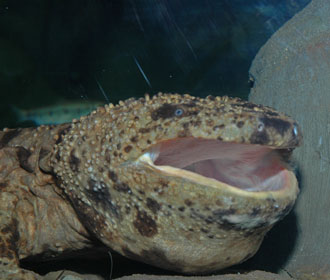 The image provided by Asa Zoo
The image provided by Asa ZooBasically Japanese Giant Salamanders eat anything moving in front of them with their huge mouth. |
It’s not Monster, It’s the Japanese Giant salamanderAsa zoological park of Hiroshima opened in 1971. Since then Asa zoo has been protecting Japanese giant salamanders. Although Japanese giant salamanders were designated as national treasure animal in 1983, the population was declining year after year. Meanwhile Asa zoo was trying to breed in captivity, at last the first generation of Japanese giant salamanders were born at the zoo in 1979. After that, the third generation was born between the couple of zoo-born salamanders. Some wild Japanese giant salamanders live in the Sijihara and the Shousai Rivers that run through northern Hiroshima. With local people Asa zoo also took part in saving wild Japanese giant salamanders for over 30 years. |
The World Biggest Amphibian - Japanese Giant Salamander
|
Now three kinds of giant salamanders are recognized in the World. Chinese and Japanese giant salamander and little bit smaller, hellbender in U.S.A. Although several habitats are reported in Japan, all of them are in west Japan, such as Gifu, Aichi, Hyougo, Okayama, Hiroshima, Simane, Yamaguchi and Oita prefecture. Rarely some salamanders are also found in Sikoku. Among them the large population lives in the Chugoku Mountain region between Hiroshima and Simane. The record size Japanese giant salamander” Yume “(means dream) was saved in Northern Hiroshima in 1993. Yume was about 150.5cm (60in) long and 271kg (600lb) in weight. Usually 5-year old salamander is about 50 cm long. Yume had been holding the record till her death in 2007. The average life span of Japanese giant salamanders in the wild is not known. Some say they can live up to 100 years in the optimum conditions. |
 Jack the Lizard
Jack the Lizard
|
|
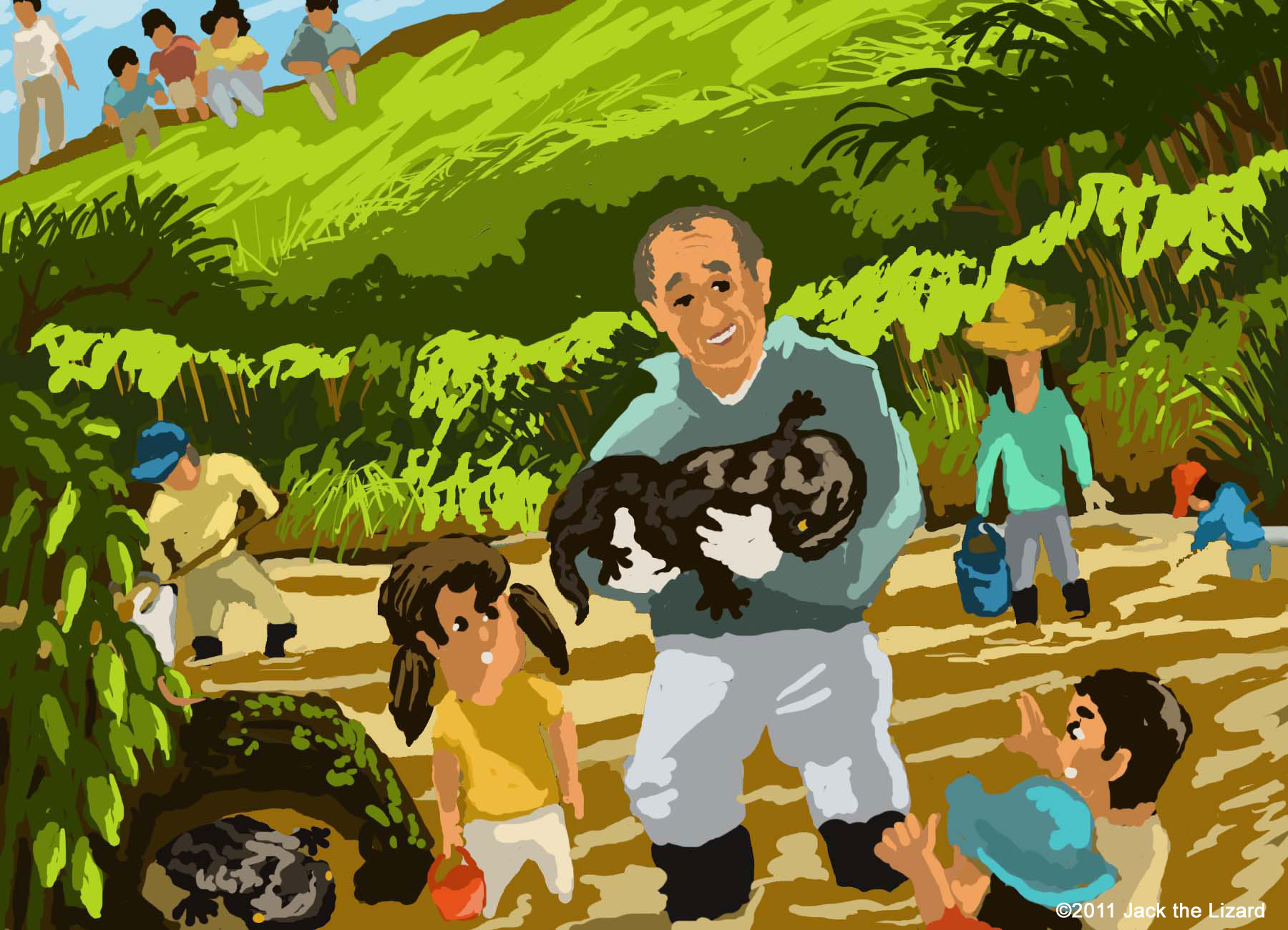
Vice director Kuwabara works with people in the river.
 The image provided by Asa Zoo
The image provided by Asa ZooJapanese Giant Salamanders can go up a stream at the river with few concrete. 
The image provided by Asa Zoo People remove mud around the nest. |
Town with "Hanzaki"Shijihara Basin is in Northern Hiroshima. The locals in Shijihara call the Japanese giant salamander “Hanzaki” that means that it is still alive even it is cut in half. After the WWⅡHanzaki was very important protein source for people to get through those difficult days. Nowadays people do not eat Hanzaki anymore, but still they appreciate and protect it as a good neighbor. Whereas saving movements continue, the habitat deteriorates gradually because of the river development. Sometimes river floors and banks need to be concreted over to control floods. But for the salamanders those constructions are disaster because they cannot breed in those environments. Therefore Asa zoo has been researching their behavior and preserving their habitat with the locals. At first the survey was conducted on the population and variety of aquatic insects live in the river, since aquatic insects are good indications of river health. In addition the zoo staffs and the river development company had meeting to discuss the issues surrounding Japanese giant salamanders. In the case of the river floor it is very difficult for the salamanders to go up the river to mate, if the river floor was covered with concrete. The steep incline of the river also give salamanders a hard time. Then they talk about the artificial nest along the river banks to help the breeding. In addition twice a year the zoo staffs have been explaining to the locals about the behavior of the salamanders since 2003. Kazushi Kuwabara vice-director of Asa zoo stresses the importance of the cooperation with the locals. “We made 6 artificial breeding nests in 1994. As we expected that the salamanders bred in those nests, but they stop breeding in 1997. The Salamanders could not enter the nest because sands covered the entrance. Then people nearby came in removing those sands. We could not protect the salamanders without the local people’s help”. “There are three key elements to live with wild animals. Knowing, protecting and giving” said Kuwabara. |
Male raise the childrenWild Japanese giant salamanders breed from July to October. According to the survey of Asa zoo large males, called “Nushi” means master, go up the river from lower to mate at the beginning of August. Then they remove mud covering the entrance of used nest. Inside the nest Nushi usually drive other males out, but once female enter the nest he let other males to stay. This behavior may come from the hormone which is secreted by females. In this way females chance to have other males’ off springs too. The observation of the nests is conducted during the night because the salamanders are nocturnal. Based on the observation up to 27 males gathered around the nest at one night. Then 5 to 6 males and females entered into a nest and stayed in about 2 hours. Usually a female lays about 500 hundreds eggs. Once eggs are laid Nushi protects eggs by himself. The eggs are laid around September and the larvae hatch around November. Then the larvae go out of the nest around February. Until then the eggs and larvae grow favorably under the protection of Nushi. But once they go out the nest survival rates drops rapidly, only 1 in 1000 larvae reaches adult. |
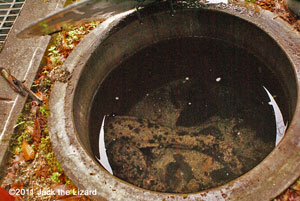
A male and a female are in the artificial nest. 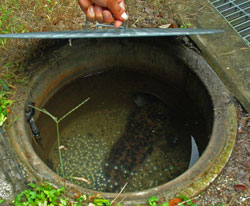 The image provided by Asa Zoo
The image provided by Asa ZooA male is protecting silver eggs. |
 Jack the Lizard |

The image provided by Asa Zoo Observation house |

Ashikaga made paper drama of Japanese Giant Salamanders to explain to the locals about the habitat and behavior.
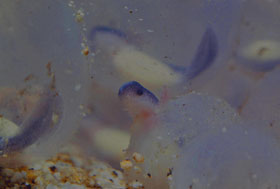 The image provided by Asa Zoo
The image provided by Asa Zoolarvae hatching from eggs |
 The image provided by Asa Zoo
The image provided by Asa ZooA larva is about 2.5cm (1in) long |

Young salamanders born in 2007,
the size is about 8cm (3in) long.
Salamanders are TreasuresRecent study revealed that Japanese Giant salamanders might be each unique individuals who live in different rivers. So Asa zoo only breed the salamanders from Otagawa river drainage system and register the blood samples of 70 individual salamanders in captivity. One of them called “Igaguri” (means Chestnut) is 30- year old now. Although she is the oldest salamanders in the zoo, she is still young princess. If wild population faces the critical situation, those salamanders in captivity will be the hope for the survival of the species. Moreover the habitat preservation is also important for the wild salamanders’ future. The salamanders eat fresh water fish and crabs that need the rocks to hide and the gentle river flow. Protecting these features of the river also preserve those little animals. Ashikaga Kazuhide, senior zoo keeper in Asa zoo, who has been participating in the observation project for many years and cooperating with the locals said, |
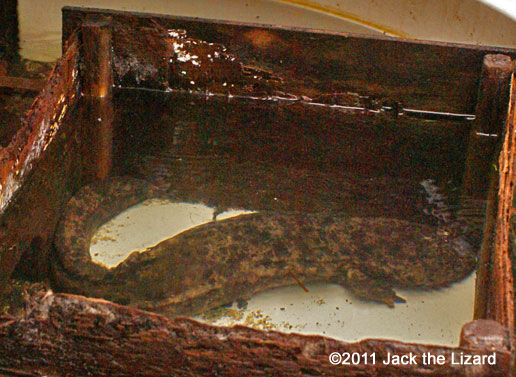 Igaguri is the oldest salamander at the zoo.
Igaguri is the oldest salamander at the zoo.
|

Director Daimaru wants to give animals suitable space and environment.
Frogs, Rhinos, Leopards all needs helpAsa zoo has several programs to save endangered species. One of them is the Nagoya Daruma Pond Frog which faces extinction in Hiroshima. There are the pond and facility to rear and breed the frogs at the zoo. Only two habitats in which the frogs live are confirmed in Hiroshima now. So the zoo is also working on protecting those places with the local. Black Rhinoceros and Amur leopards are critically endangered species in the wild. Some zoos in Japan have two species to breed and protect and Asa zoo also has them. Especially Black Rhinoceros breed successfully at Asa zoo and almost half of Black rhinos in Japan are born in Asa zoo. Hideshi Daimaru director of Asa zoo tells about the policy of rearing animals in Asa zoo. As in summer event Asa zoo opens during the night. So people come to the zoo from Hiroshima and the vicinity to enjoy watching the night life of animals. |
 Breeding facility for Japanese Giant Salamanders.
Breeding facility for Japanese Giant Salamanders.It is not open for the public, but zoo staffs invite graduate students and educator on demand. |